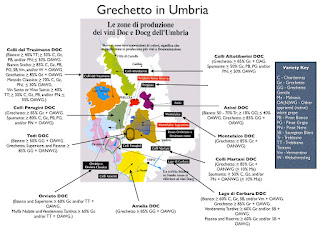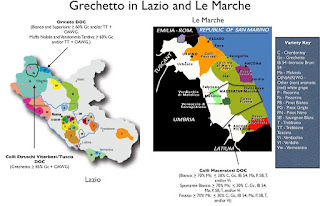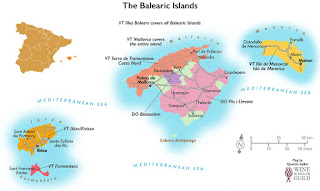Over the last few months I have been engaged in a project to map all of the DOC(G) sparkling wines of Italy. To date I have published posts on the sparkling wines of 12 of the 20 Italian regions. I have decided to pause at this time and take a look back at the grouping of wines that fall into the regions comprising Northern Italy.
The map below captures all of the DOC(G) wine zones in Northern Italy. Sparkling wine zones in Northern Italy range from one in Valle d'Aosta to 25 in Veneto. Most of the zones are DOC with a total of 14 DOCG zones. Piemonte and Veneto have the greatest number of DOCG sparkling wine zones with six and five, respectively.
The spreadsheet below shows the grape varieties used in sparkling wines segmented by region. A total of 99 varieties are employed in sparkling wine production in Northern Italy, ranging from a low of one in Valle d'Aosta to 49 in Emilia Romagna. The average is 12.375 varieties per region.
International varieties are the most broadly distributed across the regions with Chardonnay, Pinot Bianco, Pinot Nero, and Pinot Grigio each being used in six of the eight regions and Merlot in five. This fact highlights the fact that producers largely utilize regional indigenous varieties in making sparkling wines in their individual regions.
Following is a brief summary of the sparkling wines of each of the Northern Italian regions.
Piemonte Sparkling Wines
While the region is best known for its Nebbiolo grapes, and the resulting Barolo and Barbaresco wines, the below map shows that many of the appellations provide frameworks for the production of sparkling wine.
In most of the cases, the dominant DOC variety serves as the source material. If the producer does desire to do so, he/she could also utilize the much more forgiving Piemonte DOC for sparkling wine production. The map shows the designation under which sparkling wine is produced in each region and specifies the mix of allowed varieties and their relative proportions. The map also illustrates which wines are made via the Charmat Method and which use the traditional Champagne Method.
Asti DOCG is by far the largest sparkling wine appellation in Piemonte with 9700 ha under vine in 52 municipalities stretching across the provinces of Alessandria, Asti, and Cuneo. Most Asti production is via the Charmat method but, as the map shows, there is a designation for Asti Metodo Classico. The Moscato Bianco grape is used as the raw material for the Asti wine.
Alta Langa -- DOC in 2002, DOCG in 2011 -- is the new kid on the sparkling-wine block but the combination of its terroir, traditional Champagne varieties, traditional production method, skilled growers, and savvy producers bode well for the future. The Alta Langa DOCG is spread over 142 communes in the provinces of Alessandria, Asti, and Cuneo. Given the geographic scope of the region, one encounters a variety of climates, exposures, elevations and soil types. In general, the soil is a mildly fertile calcareous clay marl.
Vineyards are required to be planted at 250 m and above on the region's steep, terraced hillsides. Allowed varieties are Pinot Noir and Chardonnay and other non-aromatic grapes. Planting density is a minimum of 4000 vines/ha with the vines trained using the low espalier system and pruned traditional Guyot and spurred cordon. The maximum allowed yield is 11,000 kg/ha.
The Alta Langa producers -- 27 currently -- do not grow enough fruit to meet their needs but that gap is bridged with fruit from 80 growers who own their land and are guaranteed producer-payment for their grapes and labor.
Trentino-Alto Adige Sparkling Wines
The map below shows the sparkling wine regions of Trentino-Alto Adige.
Alto Adige DOC
I have written about the broader Alto Adige DOC
elsewhere.
According to suedtirolersekt.it, "As a result of its overall climatic conditions, the abundance of microclimates, and the composition of the soils between the Alpine mountain landscape and Mediterranean valley soils, Alto Adige is virtually ideal for the production of sparkling wines." The key characteristics (as identified by the source) are as follows:
- Locations from 500 to 1000 m
- Abundant sun during the day
- Cool temperatures during the night
- Warm soils rich in minerals
- Base wine varieties (Pinot Blanc, Pinot Noir, Chardonnay) with an affinity for the characteristic soils.
Trento DOC
Trento DOC is the specific appellation for sparkling wine produced in the Trento portion of Trento-Alto Adige. As is the case in Alto Adige, the wine is made using the Metodo Classico.
According to Kerin O'Keefe, the sparkling wines of this region show "pronounced aromatics, elegance, and bright acidity." Two producers that she recommends are Ferrari (2010 Perlé Nero Extra Brut Riserva) and Rotari (2011 Flavio Brut Riserva).
Approximately 7,500,000 bottles of sparkling wine are produced in this region annually.
Delle Venezie DOC
This region specializes in the production of Pinot Grigio in an area spanning the totality of Friuli-Venezia Guilia, Veneto, and the Trento province of the autonomous Trento-Alto Adige region. The
raisons d'etre of this expansive region are (i) proximity and (ii) pedi-climatic affinity. The wide plain between the Adriatic Sea and the Po River has been "developed over centuries by deposition of both calcareous and coarse material and gravel and sand" and also has good drainage capability.
The proximity to the Alps results in a cool and windy climate which contributes to high acid retention in the grapes, a characteristic of the wines. Water is limited but is sufficient for a regular ripening of the grapes.
The sparkling wines must be tank-fermented and must contain no more than 32 g/L of residual sugar.
Friuli-Venezia Giulia Sparkling Wines
Friuli-Venezia Giulia, the most north-eastern of the Italian wine regions, is bounded by Austria to the north, the Gulf of Trieste to the South, Slovenia to the east, and the wine region of Veneto to the west. The region's location, as well as its history, has endowed it with a richness of diverse cultural influences.
Prosecco DOC
The Prosecco DOC was first awarded in 1969 and was restricted to wines produced in the Conegliano-Valdiobbadene region. Growers felt that the brand was under attack by "imitators" using just the grape variety and moved to isolate those competitors by changing both the rules and the venue of the game. Prosecco growers agitated for, and gained regulatory acceptance of: (i) extension of the Prosecco DOC to cover all of Friuli-Venezia-Giulia and approximately two-thirds of Veneto; (ii) promotion of the original Prosecco DOC to DOCG status; (iii) changing the name of the source grape from Prosecco to Glera; and (iv) restricting the use of the name Prosecco only to Glera sparkling wines produced within the delimited zones. The growers felt that these actions would serve to protect their territory, the brand, and the quality of Prosecco. The regulations authorizing these actions came into law in 2009.
Prosecco is primarily made from the Glera (formerly Prosecco; also known as Prosecco Bianco and Proseko Sciprina) grape variety, a native of northeast Italy which has been used to produce wines since Roman times. This late-ripening, thick-skinned variety has greenish-yellow berries which evolve to a yellow-gold color as the grapes ripen. The grapes are high in acid and have a white peach aromatic profile, qualities which render them eminently suitable for the production of sparkling wines.
In addition to Glera, Prosecco wines can contain as much as 15% of other grape varieties. The most oft-used supplements are Verdiso, Branchetta, Perera, Glera Lunga, Pinot Bianco, Pinot Noir, Pinot Grigio, and Chardonnay.
Prosecco DOC wines are authorized for production in
Friuli-Venezia-Giulia and Veneto (provinces of Treviso, Belluna, Padova, Venezia, and Vicenzia). Within the broader Prosecco DOC, there are two sub-zones: DOC Treviso Prosecco and Prosecco di Trieste. These sub-zones cover Prosecco made within these two provinces and wines made therein can so indicate on their labels. Prosecco wines made in other provinces cannot carry the province name on the labels.
Valle d'Aosta Sparkling Wine
Valle d'Aosta (Vallée d"Aoste in French), is a semi-autonomous region in northwest Italy which is bounded to the north, west, and south by the Alps and shares borders with both France and Switzerland.

DOC sparkling wine production is only allowed in the Morgex and La Salle subzone and, as such, is made from 100% Prié Blanc. Hundreds of tiny old vineyard plot -- a total of 70 ha -- dot the two communes and provide fruit to the five growers and the Coop.
Two of the most notable sparkling wine producers in the region are Caves Mont Blanc and Ermes Pavese. Caves Mont Blanc is a Coop that controls 18 ha through its 80 grower-owners. It is the foremost producer of Blanc de Morgex et de La Salle. It produces a Brut and Extra Brut with the difference being a 15-month bottle aging for the former and 17 months of the latter. Ermes Pavese produces between 700 and 1200 bottles of its zero dosage sparkler only in riper years. According to Madrose, this sparkling wine is "as unusual as it is delicious, ... at once rich and quite dry, speaking clearly of its Alpine origin, with delicate smokiness and lemon curd on the nose and full earthy minerality on the palate."
These are small-production wines that are difficult to obtain outside the market.
Lombardia Sparkling Wines
As shown in the chart below, there are eight DOC(G) sparkling wine appellations in Lombardia.
Two of these appellations (Franciacorta DOCG and Oltrepò Pavese Metodo Classico) are (i) sparkling-wine specific and (ii) utilize the Champagne method in the production process. In addition, Oltrepò Pavese DOC and Sangue di Giuda DOC are Charmat, with the remaining appellations accomodating either the Charmat or Metodo Classico methods.
With the exception of Riviera del Garda Classico DOC and Sangue di Giuda DOC, all appellations provide for a white sparkling wine. With the exception of Lugana DOC, Sangue di Giuda DOC, and Terre del Colleoni, all regions provide for the production of a Rosé. With the exception of Franciacorta, Lugana, and Riviera del Garda Classico, all regions allow for the production of varietal sparkling wines. Sangue di Giuda DOC is the only region that specifies a red sweet sparkling wine.
Franciacorta, Oltrepò Pavese Metodo Classico, and Terre del Colleoni allow for the production of vintage-dated sparklers while, in addition, Franciacorta and Oltrepò Pavese Metodo Classico allow for production of Riservas. Vintage-dated and Riserva sparkling wines are required to spend more time on the lees.
A total of 25 varieties are authorized for sparkling wine production across the region; many of these varieties are utilized in one or two applications. The almost ubiquitous varieties are Chardonnay, Pinot Noir, Pinot Banco, and Pinot Grigio.
Veneto Sparkling Wines
Veneto is the ancestral home of Prosecco, the Italian sparkler of the day, but it is also home to wide range of other, mostly unheralded sparkling wines.
The two charts following map the distribution of sparkling wines in Veneto. Of 14 DOCGs, five produce sparkling wines (and three of those are sweet); of 29 DOCs, 20 produce one or more sparkling wines.
There are two sparkling-wine-only appellations: Lissini Durello and Vigneti della Serenissima DOCs. The dominant method of sparkling-wine production is Charmat. A total of four appellations are shared with neighboring regions: Garda and Lugana DOCs with Lombardia; Prosecco DOC with Friuli-Venezia Giulia; and Delle Venezie DOC with Trento and Friuli-Venezia Giulia.
Emilia-Romagna Sparkling Wines
With 136,000 acres under vine, Emilia-Romagna is the second-largest wine-producing region in Italy after Veneto. The largest wine-producing areas in the region are found in the alluvial plains but the wines from the foothills are attracting attention.
Of the 21 official Emilia-Romagna appellations (2 DOCGs, 19 DOCs), 10 (one DOCG and nine DOCs) provide at least one label under which sparkling wine can be produced. In a number of cases -- Colli di Parma DOC and Colli Piacentini DOC, for example -- the availability of varietal-specific labels provides the producer with the potential to offer between four and six separate sparkling wines.
The biggest concentration of sparkling wine production occurs in the area between Reggio Emilio in the northwest and Bologna, with the Lambrusco zone around Modena serving as the beating heart of this geographic range.
In terms of production methods, 10 of the available labels are Charmat-only while two follow the
Champenoise method. All of the other labels allow for the use of both methods based on the producer's preference.
Liguria Sparkling Wines
As shown in the chart below, sparkling wine is produced in the Val Polcèvera and Golfo del Tigullio - Portofino DOCs.
In both of these DOCs, Bianchetto Genovese and Vermentino are featured players while a variety called Albarola is additionally given prominence in Val Polcèvera DOC. It should be noted that a 2009 DNA study has concluded that Albarola and Bianchetto Genovese are genetically identical.
Abissi Sparkling Wine
Bisson Winery has been aging its Metodo Classico wines in 60 meters of water off the coast of Portofino since 2005. The wines -- there are three of them: Spumante Classico, Spumante Riserva, and Spumante Rosé -- are fermented traditionally to produce the base wines and are then bottled and lowered into the sea in July so that the second fermentation can be completed in the anaerobic conditions below the surface of the water.
The Spumante Classico and Riserva are blends of Bianchetto Genovese, Vermentino, and a third cultivar called Cimixià. The Rosé is a blend of Granaccia and Ciliegiolo.
The innovative method of aging is the brainchild of Pierluigi Lugano, the enterprise's winemaker. "When the wine bottles are picked up, they are enriched with incrustations (sic), seaweeds (and sometimes shellfishes, too) ... For health and sanitary reasons, bottles are then dried and wrapped under a protective, clear film, which also serves the purpose of preserving the natural ornament made by the sea,"
©Wine --
Mise en abyme



































